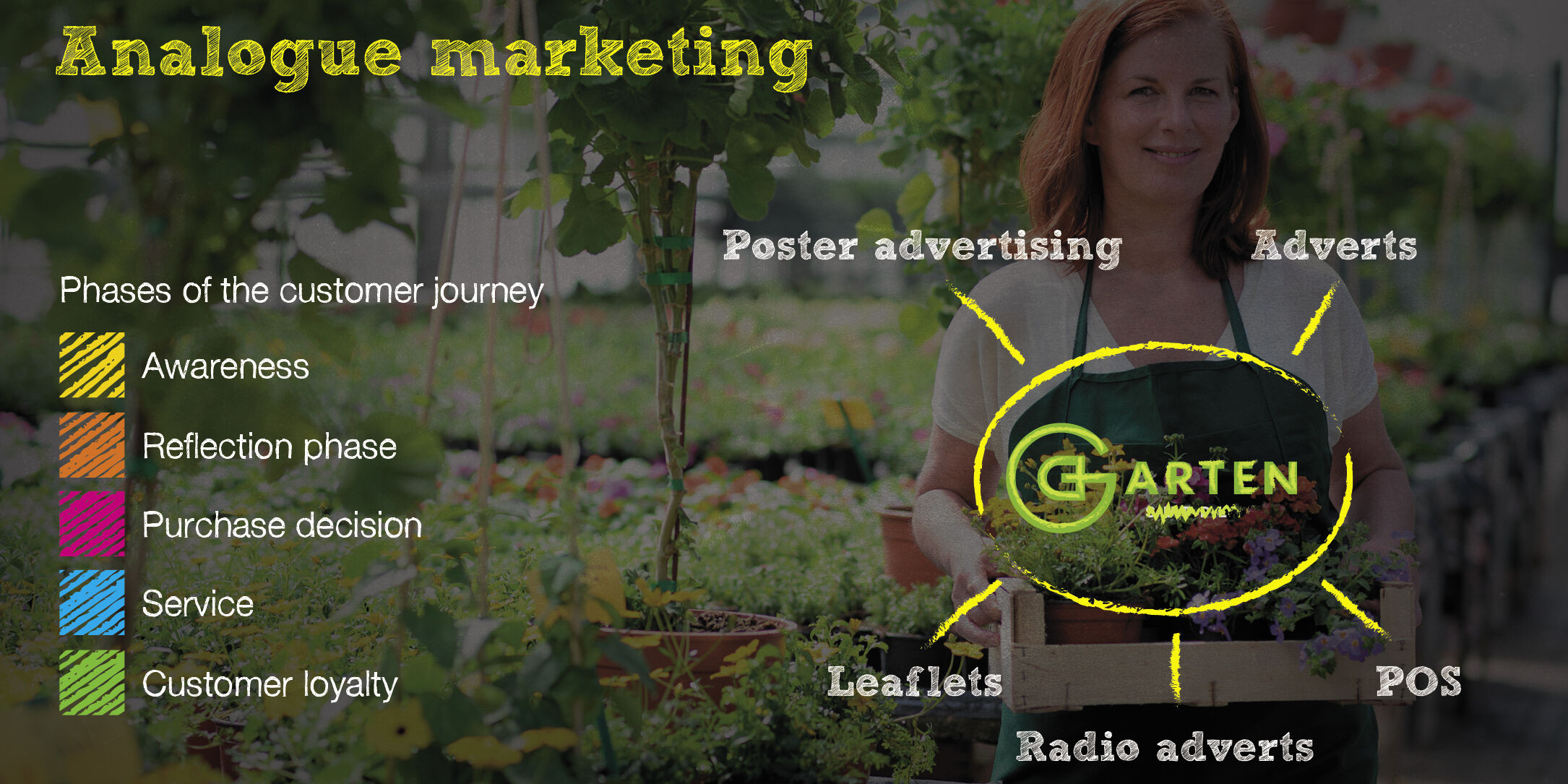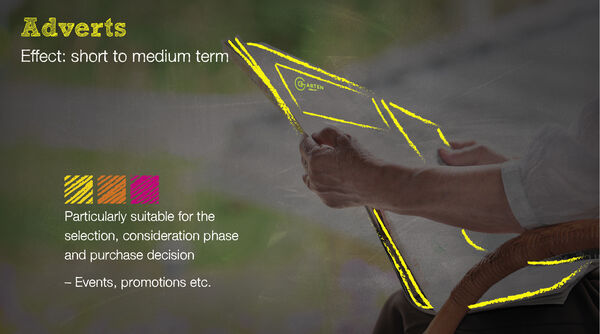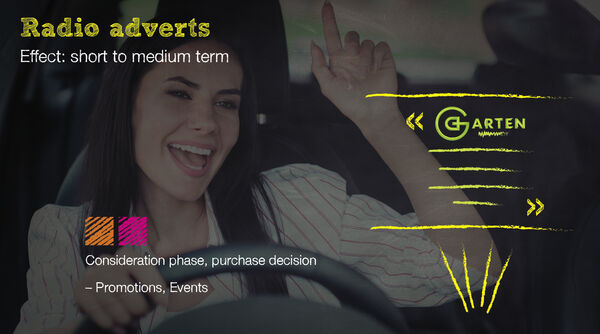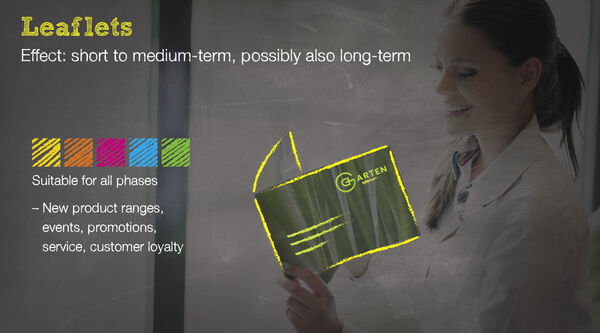Analog marketing is often referred to as classic advertising, as it encompasses the marketing tools that have shaped marketing since its beginnings. Digital marketing has opened up completely new, additional possibilities. However, analog advertising media also offer opportunities and are becoming more important again in some cases.
The right bait
It is crucial that advertising messages in analog media are also adapted to the changing habits and needs of customers. After all, not much has actually changed in terms of the reach of traditional media. The big difference compared to the past is that the marketing pond in which people fish has become a sea thanks to the digital possibilities, in which one or two advertising messages naturally get lost. What's more, there are suddenly many more fishermen who are also fishing for customers. This makes it all the more crucial to lay out the "right bait" with analog advertising.
An example: At the turn of the millennium, a 10% discount promotion was still eye-catching and drew customers into the store. Today, you can hardly attract anyone with a 10% discount. Small gifts or a special experience, on the other hand, are well received today and should be communicated accordingly in advertising.
What speaks for analog advertising?
One aspect that should not be underestimated is that the older generation still has a high affinity for analog media. And in the green sector in particular, this generation is still the most important clientele. The fact that traditional marketing is important and successful despite digitalization is also shown by the fact that Switzerland's largest and most successful online retailer continues to invest a lot of money in traditional advertising to attract customers to its online store.
What is usually underestimated: Lifestyle habits, behaviors and social trends are constantly changing, and new needs are emerging that want to be satisfied. For example, there is a strong trend towards local, sustainable products. Our retail grower Martina*, for example, produces part of her range herself. However, potential customers in their area need to know about this so that they buy locally from Martina. Traditional media have a clear advantage here and are more effective than digital media.
Advertisements
In the past, advertisements were probably the most common form of advertising for SMEs. However, the media landscape has changed fundamentally over the past ten years. Many newspapers have disappeared or merged. What they all have in common is that circulation and therefore readership have fallen sharply. In rural areas, however, regional newspapers are still very important as they provide local reporting. Most titles are now also published digitally. This means that potential customers can also be reached digitally with an advertisement. Most advertising rates are still at a similar level to the past despite massively smaller circulations.
Recommendation: Newspaper advertisements are particularly suitable for events and promotions. Newspapers that are distributed to all households and are also noticed (official gazette character) are interesting.
Posters
In the case of billboards, the trend is the opposite. The population is on the move more than before, whether by private or public transport. As a result, most poster sites are seen by more people than before. The large spaces offer a good opportunity to attract attention and convey a message in a positive way. Posters can of course also be put up on your own premises. In addition, the production of posters and, in particular, billboards has become extremely cheap, so that billboards/posters are also worthwhile for events.
Recommendation: Posters are particularly suitable for events that need to be publicized regionally. With an exciting subject, the image of the company can also be enhanced.
Radio and TV advertising
Local radio stations often offer attractive advertising opportunities that can also be of interest to SMEs. Despite streaming and countless digital options for consuming music, radio still has a wide reach. Well-placed advertising messages that are repeated regularly can certainly reach the target customer. It becomes somewhat more difficult if you are active in an area that is frequented by several stations. The question then inevitably arises as to which radio station to use to reach the desired target group. The situation is similar with advertising on local television.
Recommendation: Short, inexpensive spots can be particularly successful at events. Success depends heavily on the catchment area and the target audience.
Mailing/Prospectus
The prophesied dead live longer. The end of print advertising has been prophesied several times and yet it continues to enjoy great popularity and attention. On the positive side, printing costs have fallen massively, even for small print runs, and there are countless new options in terms of shape and size. One negative development is that more and more letterboxes are being fitted with a stop advertising sticker and can therefore no longer be reached. To get around this, there is the option of sending addressed print advertising or enclosing it with a newspaper, for example.
Brochures that regularly reach customers and contain high-quality content or attractive offers attract a lot of attention. Hardly any other instrument can be used to advertise all phases of the customer journey at the same time. You can present new products, go into more detail about topics, trigger a purchase with a promotion, draw attention to your services and collect customer addresses with a competition or voucher. These are all reasons why online-only stores also use print advertising.
Markus*, for example, has developed a customer magazine for his business that provides information on interesting topics relating to the garden and his business in spring and fall. He regularly introduces his employees or gives valuable gardening tips. There is also always an in-depth topic on ecological aspects of the gardening world. He sends the customer magazine to all his customers.
For the spring and Christmas exhibitions, Martina* distributes a large postcard as an invitation and voucher. This form of advertising is also very eye-catching and can be realized with a small budget.
Recommendation: Print is still one of the most important tools in the marketing mix and has a high marketing value when used correctly. Large-format postcards in particular can achieve a high advertising impact very cost-effectively.
Address acquisition and management.
A good and, above all, up-to-date address base is the be-all and end-all for every company, especially for SMEs. Knowing who your customers are and where they come from is essential for successful marketing. How do you get the addresses? As a horticultural business with end customer contact, you will receive many addresses through inquiries, offers, etc. Ask each customer if they are interested in receiving high-quality information or an invitation to an exclusive event. A customer card is recommended in the retail trade. This can be linked to special offers as well as exclusive information. It is important that the customer feels valued and does not just have another card in their wallet. The customer card also offers the opportunity to greet the customer by name at the checkout at the latest. This personal level in particular is often underestimated and has great potential if used correctly.
Recommendation: The less personal data is collected and the more transparently it is communicated what happens to the address data and what kind of advertising the customer receives, the more willing customers are to provide this information.
POS marketing
The point of sale is the retail trade's great opportunity compared to online retail. There are people on site with whom you can talk, where you can sense the mood, both positive and negative. Customers can look at the goods, smell them, feel them, etc. Beautiful, inspiring product presentations turn shopping into a customer experience. This personal involvement should not be withheld from the customer.
POS design is a balancing act between a forest of signs and useful information for customers. Good signage increases the self-service rate. It relieves the burden on sales staff, which can be a decisive factor in countering the shortage of skilled workers or getting the most out of the sales area with the existing sales staff. It is also important that the POS information is well integrated into the marketing mix or that the POS measures are coordinated with the marketing mix. If an item is advertised in a brochure, it must also be easy to find in the store.
When planning signage, it is often forgotten that the customer may be visiting you for the first time and first needs to find their way around. This is where simple basic labeling and guidance can help. Try to put yourself in the customer's shoes. What are they looking for, what information do they need? The information is often far too technical. Simple flyers with in-depth information for customers who want to know more are good aids.
To avoid the impression of a forest of signs, all POS materials should have the same design. This makes the whole appearance less confusing and the customer can immediately recognize that it is information from the store. Especially for information that can be taken away, it is important that your company's logo and address are printed on it.
Regardless of which analog marketing measures you implement, it is crucial that this information is also implemented digitally so that a common thread runs through your entire communication. You can find out what digital options are available in the next article.
*Markus has a thriving landscaping business with 20 employees. He is mainly active in the private sector, mainly doing high-quality remodelling and maintenance work. The order books are usually full months in advance. So Markus asks himself why he should spend money on marketing when things are going well anyway.
*Martina runs a small garden retail business in a good location with her own plant production, mainly seasonal flowers, herbs and vegetables. She has been able to count on a loyal clientele for a long time, but is slowly realising that her customers are getting older and older and tending to decline. Martina wonders how she can attract more customers with her small marketing budget.








